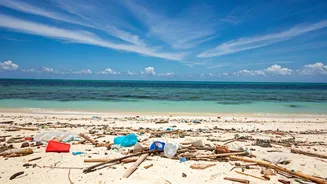Beach Dissatisfaction Uncovered
The allure of sun, sand, and sea often masks potential problems at popular beaches. Many travelers have voiced their discontent, leading to compiled lists
of beaches consistently generating complaints. Several recurring issues contribute to this dissatisfaction, with dirtiness and excessive noise topping the list. Overcrowding, lack of amenities, and the presence of litter are also significant grievances. These factors collectively diminish the enjoyment of a beach visit, transforming what should be a relaxing experience into a frustrating one. Some beaches have been repeatedly criticized for their inability to maintain cleanliness, while others are notorious for disruptive noise levels that overshadow the tranquility expected from a coastal retreat. Understanding these common sources of displeasure is the first step in ensuring a more pleasant beach experience.
Dirty Beaches Revealed
One of the most frequent complaints regarding beaches worldwide centers on cleanliness. Many beaches struggle to maintain a pristine environment, with trash and debris accumulating due to several factors. These factors include inadequate waste management infrastructure, a lack of public awareness regarding proper disposal, and the influence of tides and weather conditions, which can deposit litter on the shore. Some beaches, despite their popularity, are particularly prone to these issues. The accumulation of garbage not only detracts from the aesthetic appeal of the beaches but also poses a health hazard to both visitors and local wildlife. It contaminates the sand and water, and can lead to serious health problems. The situation highlights the urgent need for more effective waste management strategies, along with increased public awareness campaigns aimed at promoting responsible beach use.
Noise Pollution Concerns
Beyond cleanliness, noise pollution is another significant factor contributing to beach dissatisfaction. Many beaches are criticized for excessive noise levels, which can ruin the peaceful atmosphere that most visitors seek. The sources of noise pollution vary widely. Some beaches are plagued by loud music emanating from nearby bars or clubs. Other beaches experience disruptive noise from motorized watercraft, such as jet skis, which can be particularly intrusive. Additionally, crowds of people can create considerable noise, especially during peak seasons. This excessive noise significantly diminishes the relaxation that visitors expect. The negative effects include heightened stress levels and an inability to fully enjoy the natural sounds of the ocean. Efforts to mitigate noise pollution are critical to restoring the tranquility of these beach environments.
Overcrowding Issues Explored
Overcrowding is a frequent source of complaints at popular beaches globally. The increasing number of visitors, especially during peak seasons, can lead to unpleasant conditions, severely impacting the quality of the beach experience. Overcrowding often results in reduced personal space, making it difficult to find a comfortable spot to relax. It can also lead to longer wait times for facilities, such as restrooms and food vendors. Furthermore, increased crowds can contribute to higher levels of noise and litter, thus adding to the existing problems. Managing overcrowding is a complex challenge, requiring strategic planning, which can include limiting the number of visitors, providing more amenities to handle large crowds, and promoting responsible beach practices. The goal is to provide a balanced and enjoyable experience for all visitors.
Amenities and Their Lack
The lack of adequate amenities is another frequent cause of beach dissatisfaction. Many beaches fail to provide sufficient facilities to meet the needs of visitors, leading to a poorer overall experience. Common deficiencies include insufficient restrooms, inadequate changing facilities, and a lack of proper waste disposal systems. In addition to these basic needs, some beaches lack essential amenities. Limited access to food and beverages can be a source of frustration, particularly for families with children. The absence of shade or seating areas also makes it difficult to enjoy the beach during the hottest hours of the day. Providing these amenities is crucial for enhancing visitor satisfaction. This requires careful planning and investment in appropriate infrastructure to meet the demands of beachgoers.
Litter and Waste Problems
Litter and waste management issues are widespread across many of the beaches that draw the most complaints. The presence of trash, both on the sand and in the water, drastically reduces the aesthetic appeal and overall enjoyment. The causes of litter problems are multi-faceted, including a lack of adequate waste disposal facilities, insufficient cleaning efforts, and a lack of public awareness. Visitors often leave behind their waste, contributing to the problem. Waste accumulation can also be compounded by the impact of tides and winds, which can deposit trash from offshore sources. The environmental consequences of litter are severe. It poses a threat to marine life, contaminates the water, and detracts from the natural beauty of the beach. Effective waste management strategies, public awareness campaigns, and regular cleanup efforts are essential for keeping beaches clean.
Specific Beach Examples
Certain beaches have consistently been mentioned in complaints. These beaches, often popular destinations, struggle to manage the environmental and logistical challenges of hosting large numbers of visitors. The specific issues vary from beach to beach, but common themes include cleanliness, noise levels, and the provision of amenities. Some beaches may be overwhelmed with trash, while others struggle with excessive noise. Knowing the problems associated with some of the more complained about beaches, helps tourists make choices that will improve their overall experience. This also encourages discussions and helps support local authorities. This awareness plays a crucial part in the ongoing effort to improve the quality of beach environments worldwide.
Improving Beach Experiences
Improving the overall beach experience requires a combination of strategies. Several actions can significantly improve the quality of the beaches and reduce the issues causing complaints. Effective waste management is a key component, with sufficient trash bins and regular cleanup schedules. Noise regulations can help create a more relaxing atmosphere by managing sound levels. Increased amenities, such as restrooms, changing facilities, and food vendors, are essential. Public awareness campaigns, encouraging responsible beach use, are also critical. Education about proper waste disposal, respect for the environment, and the importance of preserving the natural beauty of the beaches can make a significant difference. Collaboration among local authorities, beach management, and visitors is crucial for success.
Responsible Beach Tourism
Responsible tourism is essential to ensure a positive beach experience and preserve the environmental quality of coastal destinations. Responsible tourism involves several key practices that visitors can adopt to minimize their impact on beaches. These include proper waste disposal, packing out all trash and using designated bins. Visitors can also minimize noise and respect the natural environment. Choosing eco-friendly products, supporting local businesses, and avoiding activities that harm marine life can also improve the quality of the beach experience. Furthermore, respecting the local culture and guidelines can contribute to a more positive experience for everyone. Engaging in responsible practices helps ensure the beauty and enjoyment of beaches for future generations.
Future Beach Destinations
As tourism continues to evolve, understanding the reasons behind beach complaints becomes essential for future beach destinations. Focusing on sustainable practices, thoughtful planning, and addressing the root causes of current issues can set a new standard for beach destinations. Some of these trends are already emerging, with efforts focused on eco-friendly facilities, noise management, and community engagement. By analyzing the current problems, developers and authorities can create beaches that prioritize visitor satisfaction, and environmental protection. Ultimately, this approach will ensure that beaches remain enjoyable destinations, offering memorable experiences for years to come.












